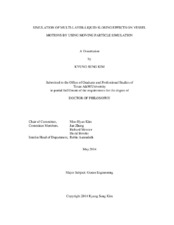| dc.description.abstract | The coupling and interactions between ship motions and inner-liquid tank
sloshing have been investigated by a coupled program between ship motion and sloshing
analysis programs. For the sloshing program, Moving Particle Simulation (MPS), which
is based on the Lagrangian approach, is used. This sloshing program is validated through
comparisons with corresponding experimental results both qualitatively and
quantitatively. This validated MPS method has been extended to multi-liquid systems by
adding newly adopted models which are buoyancy-correction, surface tension, and
boundary conditions at interfaces. Each new model is validated either mathematically or
theoretically for comparison. Moreover, a new tracing method of interface particles is
suggested by modifying the conventional free-surface searching method in MPS for a
single-liquid system. The newly developed MPS for multi-liquid system has been tested
for three-liquid sloshing and the obtained results have been compared with the
corresponding experimental results. The verified MPS system is coupled with a ship
motion program to investigate the sloshing effects on vessel motions. The coupled
program was applied to two sloshing tanks, partially filled with fresh water, on a barge-type
FPSO. The simulation results were compared with experiments by MARIN and
showed good agreement. The most noticeable coupling effects on vessel motions show
that the peak frequencies are split and shifted, especially in roll motions. Furthermore,
comparison between cases of liquid- and rigid-cargo showed the importance of sloshing
effects more clearly. The developed program was also applied to the multi-liquid
sloshing problem to consider the wash-tank. In the case of the multi-liquid-layer, there are more than one sloshing natural frequencies, so the relevant physics can be much more complicated compared to the case of a single-liquid-tank. The oscillations of the interfaces have different amplitudes and frequencies. Since the wash-tank contained multi-liquids, short waves at the interface were generated due to Kelvin-Helmholtz instability and the phenomenon was successfully reproduced by the developed MPS-simulation technique. | en |


